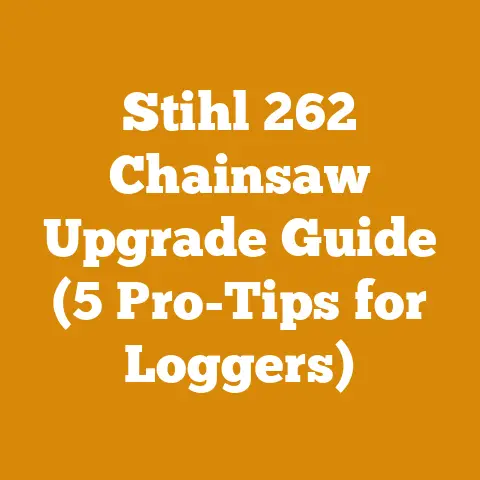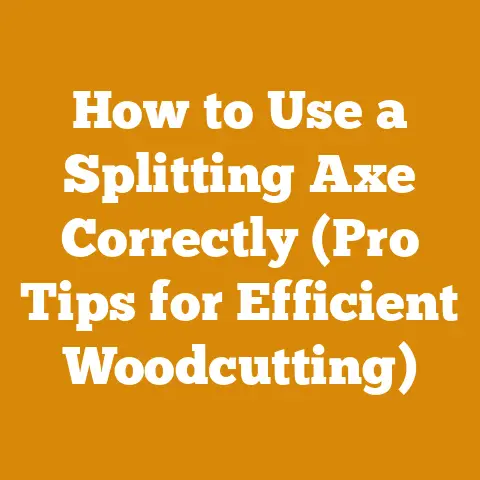Attachment Capable Trimmers: Choosing Compatible Tools (Pro Tips)
That’s why I’m diving deep into attachment-capable trimmers – those versatile workhorses that can transform into hedge trimmers, pole saws, edgers, and more. Choosing the right one can be a game-changer, saving you money, space, and a whole lot of backaches. So, let’s get started!
Attachment Capable Trimmers: Choosing Compatible Tools (Pro Tips)
Attachment-capable trimmers are the Swiss Army knives of the yard work world. They offer the flexibility to handle multiple tasks with a single powerhead. But, with so many options on the market, figuring out which attachments work with which trimmers can feel like navigating a jungle. I’ve spent years in the field, from managing small-scale firewood operations to consulting on larger logging projects, and I’ve learned a thing or two about making the right choices.
Understanding the Core Concept: Powerheads and Attachments
At its heart, an attachment-capable trimmer consists of two main components: the powerhead (the engine and handle) and the attachments (the tools that connect to the powerhead). The beauty of this system is that you only need one engine to power a variety of tools, which can save you a significant amount of money and storage space.
Think of it like this: You wouldn’t buy a separate car engine for every type of vehicle you own, would you? The same principle applies here. A single, robust powerhead can drive a trimmer, edger, pole saw, hedge trimmer, and more. It’s all about compatibility and making sure you choose the right tools for the job.
Why Choose an Attachment-Capable Trimmer?
Before we get into the nitty-gritty, let’s quickly cover why you might opt for an attachment-capable trimmer in the first place.
- Versatility: One tool, many jobs. From trimming grass to pruning high branches, these trimmers can do it all.
- Cost-Effectiveness: Buying one powerhead and several attachments is often cheaper than buying individual tools for each task.
- Storage Space: Say goodbye to clutter! With fewer tools to store, you’ll free up valuable space in your garage or shed.
- Ease of Use: Once you get the hang of switching attachments, you’ll find it’s a breeze to transition between tasks.
The biggest challenge with attachment-capable trimmers is ensuring compatibility. Not all attachments work with all powerheads. Manufacturers often have proprietary systems, which means an attachment from one brand might not fit a powerhead from another.
Brands and Their Ecosystems
Here’s a look at some of the major players in the attachment-capable trimmer market and their ecosystems:
- Stihl: Stihl is known for its KombiSystem, a robust and reliable platform that offers a wide range of attachments. Their system is generally considered to be professional-grade and is popular among landscaping professionals.
- Echo: Echo offers the Pro Attachment Series (PAS), which is another well-regarded system. Echo attachments are known for their durability and performance.
- Husqvarna: Husqvarna’s attachment system is versatile and compatible with a range of tools. They offer both gas and battery-powered options.
- Ryobi: Ryobi’s Expand-It system is a popular choice for homeowners due to its affordability and wide availability.
- Craftsman: Craftsman offers a range of attachments that are compatible with their powerheads, providing a good balance of performance and value.
A Personal Anecdote: I once had a client who bought a Ryobi powerhead and a Stihl attachment, thinking they would work together. It was a classic case of “measure twice, cut once” gone wrong. The attachment simply wouldn’t fit, and he ended up having to return the Stihl attachment and purchase a compatible Ryobi one. This experience taught me the importance of always checking compatibility charts and reading reviews before making a purchase.
Understanding Attachment Mechanisms
Attachment mechanisms vary between brands and models. Some common types include:
- Quick-Connect Systems: These systems use a lever or button to quickly attach and detach tools. They are convenient and easy to use.
- Threaded Connectors: These systems require you to screw the attachment onto the powerhead. They are generally more secure but can be a bit more time-consuming to use.
- Pin-Lock Systems: These systems use a pin to lock the attachment in place. They are simple and reliable.
Compatibility Charts and Resources
The best way to ensure compatibility is to consult the manufacturer’s website or user manual. Most manufacturers provide compatibility charts that list which attachments are compatible with which powerheads. These charts can be invaluable in preventing costly mistakes.
Pro Tip: Don’t rely solely on the manufacturer’s information. Read customer reviews and forums to see if other users have had success (or failures) with specific combinations.
Choosing the Right Powerhead: Gas vs. Battery
One of the first decisions you’ll need to make is whether to go with a gas-powered or battery-powered powerhead. Both options have their pros and cons.
Gas-Powered Powerheads
Pros:
- Power: Gas-powered powerheads generally offer more power than battery-powered models. This makes them ideal for heavy-duty tasks like cutting thick brush or felling small trees.
- Runtime: You can run a gas-powered powerhead for as long as you have fuel. There’s no need to stop and recharge batteries.
- Cost: Gas-powered powerheads are often cheaper than their battery-powered counterparts.
Cons:
- Maintenance: Gas-powered engines require regular maintenance, including oil changes, spark plug replacements, and air filter cleanings.
- Noise and Emissions: Gas-powered engines are noisy and produce emissions, which can be a concern in residential areas.
- Weight: Gas-powered powerheads tend to be heavier than battery-powered models, which can be tiring to use for extended periods.
Data Point: According to a survey conducted by the Outdoor Power Equipment Institute (OPEI), gas-powered trimmers still account for approximately 60% of the market share, but battery-powered models are rapidly gaining popularity.
Battery-Powered Powerheads
Pros:
- Convenience: Battery-powered powerheads are easy to start and require minimal maintenance.
- Quiet Operation: Battery-powered engines are much quieter than gas-powered models, making them ideal for noise-sensitive environments.
- Zero Emissions: Battery-powered engines produce zero emissions, making them a more environmentally friendly choice.
- Lightweight: Battery-powered powerheads are generally lighter than gas-powered models, which can reduce fatigue during use.
Cons:
- Power: Battery-powered powerheads may not offer as much power as gas-powered models, especially for heavy-duty tasks.
- Runtime: Battery runtime is limited, and you’ll need to stop and recharge batteries periodically.
- Cost: Battery-powered powerheads and batteries can be more expensive than gas-powered models.
Case Study: A local landscaping company switched from gas-powered trimmers to battery-powered models for their residential clients. They found that the reduced noise levels and zero emissions were a major selling point, and their clients appreciated the quieter operation. However, they also had to invest in extra batteries to ensure they could complete their jobs without interruption.
Essential Attachments: What You Need and Why
Now that we’ve covered powerheads, let’s take a look at some essential attachments.
Trimmer Head
The trimmer head is the most basic attachment and is used for cutting grass and weeds. There are two main types of trimmer heads:
- String Trimmer Heads: These heads use nylon string to cut vegetation. They are versatile and can be used for a variety of tasks.
- Blade Trimmer Heads: These heads use metal blades to cut vegetation. They are more effective for cutting thick brush and weeds.
Pro Tip: Consider using a trimmer head with an easy-loading system. These heads allow you to quickly and easily replace the string without having to disassemble the head.
Edger
The edger attachment is used to create clean, crisp edges along sidewalks, driveways, and flower beds. It features a vertical blade that cuts into the soil, creating a professional-looking edge.
Personal Experience: I used to spend hours edging my lawn with a manual edger. It was back-breaking work, and the results were never quite as good as I wanted. Once I switched to an edger attachment, my edging time was cut in half, and the results were much more consistent.
Hedge Trimmer
The hedge trimmer attachment is used to trim and shape hedges and shrubs. It features a long, reciprocating blade that can cut through branches up to a certain thickness.
Data Point: According to a study by the University of California, pruning hedges regularly can improve their overall health and appearance.
Pole Saw
The pole saw attachment is used to prune high branches that are out of reach from the ground. It features a small chainsaw on the end of a long pole, allowing you to safely and easily trim branches without having to climb a ladder.
Safety First: Always wear safety glasses, a helmet, and gloves when using a pole saw. Be aware of your surroundings and avoid cutting branches that could fall on you or others.
Brush Cutter
The brush cutter attachment is used to clear thick brush and weeds. It features a rotating blade that can cut through dense vegetation.
Real-World Application: I once used a brush cutter attachment to clear a heavily overgrown area on a client’s property. The area was so thick with brush that it was almost impassable. The brush cutter made quick work of the vegetation, and we were able to transform the area into a usable space in just a few hours.
Cultivator
The cultivator attachment is used to till soil and prepare it for planting. It features rotating tines that break up the soil, making it easier to plant seeds or seedlings.
Pro Tip: Use a cultivator attachment to prepare your garden beds in the spring. This will help to loosen the soil and make it easier for your plants to grow.
Beyond the Basics: Advanced Attachments and Applications
While the attachments we’ve discussed so far are the most common, there are also a number of more specialized attachments available.
Blower
The blower attachment is used to clear leaves, debris, and snow from sidewalks, driveways, and lawns. It’s a convenient alternative to using a separate leaf blower.
Dethatcher
The dethatcher attachment is used to remove thatch (a layer of dead grass and debris) from your lawn. Removing thatch can improve the health of your lawn by allowing water and nutrients to reach the soil.
Sweeper
The sweeper attachment is used to sweep sidewalks, driveways, and patios. It features a rotating brush that sweeps away dirt, leaves, and other debris.
Snow Thrower
The snow thrower attachment is used to clear snow from sidewalks, driveways, and other areas. It’s a convenient alternative to using a separate snow blower, especially for smaller areas.
Making the Right Choice: Factors to Consider
Choosing the right attachment-capable trimmer involves considering several factors.
Budget
Attachment-capable trimmers can range in price from a few hundred dollars to over a thousand dollars. Set a budget before you start shopping, and stick to it.
Frequency of Use
If you plan to use your trimmer frequently, invest in a high-quality model that is built to last. If you only plan to use it occasionally, a less expensive model may suffice.
Task Requirements
Consider the types of tasks you’ll be performing with your trimmer. If you need to cut thick brush or prune high branches, you’ll need a more powerful powerhead and attachments.
Storage Space
If you have limited storage space, choose a trimmer with a compact design and attachments that can be easily stored.
Ergonomics
Choose a trimmer that is comfortable to use. Look for features like adjustable handles, padded grips, and vibration dampening.
Brand Reputation
Choose a trimmer from a reputable brand that is known for its quality and reliability. Read customer reviews to get an idea of the pros and cons of different models.
Safety First: Best Practices for Using Attachment-Capable Trimmers
Safety should always be your top priority when using any type of power tool. Here are some best practices for using attachment-capable trimmers:
- Read the User Manual: Before using your trimmer, read the user manual carefully. Pay attention to all safety warnings and instructions.
- Wear Safety Gear: Always wear safety glasses, hearing protection, gloves, and sturdy shoes when using your trimmer.
- Inspect the Equipment: Before each use, inspect your trimmer and attachments for any signs of damage. Do not use the equipment if it is damaged.
- Clear the Area: Before starting your trimmer, clear the area of any obstacles, such as rocks, branches, and toys.
- Keep a Safe Distance: Keep a safe distance from other people and pets when using your trimmer.
- Use the Right Attachment: Use the correct attachment for the task at hand. Do not use an attachment for a purpose for which it was not designed.
- Maintain Proper Posture: Maintain proper posture when using your trimmer. Avoid bending over or twisting your body.
- Take Breaks: Take frequent breaks to avoid fatigue.
- Store Properly: Store your trimmer and attachments in a safe and dry place.
Real-World Example: I once witnessed a serious accident involving a trimmer. A homeowner was using a trimmer to clear weeds around a fence when the trimmer head struck a piece of metal hidden in the grass. The metal projectile struck him in the leg, causing a deep laceration. He was lucky that the injury wasn’t more serious. This incident highlights the importance of wearing safety gear and clearing the area before using a trimmer.
Maintenance Matters: Keeping Your Trimmer in Top Shape
Proper maintenance is essential for keeping your attachment-capable trimmer in top shape. Here are some maintenance tips:
- Clean the Equipment: After each use, clean your trimmer and attachments with a damp cloth.
- Sharpen Blades: Sharpen the blades on your edger, hedge trimmer, and brush cutter attachments regularly.
- Replace String: Replace the string on your trimmer head when it becomes worn or frayed.
- Check Oil Level: Check the oil level in your gas-powered powerhead regularly.
- Clean Air Filter: Clean the air filter in your gas-powered powerhead regularly.
- Replace Spark Plug: Replace the spark plug in your gas-powered powerhead periodically.
- Lubricate Moving Parts: Lubricate the moving parts on your trimmer and attachments regularly.
- Store Properly: Store your trimmer and attachments in a safe and dry place.
Data Point: According to a study by Consumer Reports, regular maintenance can extend the life of your power tools by as much as 50%.
The Future of Attachment-Capable Trimmers
The future of attachment-capable trimmers is bright. As battery technology continues to improve, battery-powered models will become even more powerful and efficient. We can also expect to see more innovative attachments and features in the years to come.
Predictions:
- Increased Battery Power: Battery-powered powerheads will offer more power and longer runtime.
- Smart Technology: Trimmers will incorporate smart technology, such as GPS tracking and performance monitoring.
- More Specialized Attachments: We’ll see more specialized attachments designed for specific tasks.
- Improved Ergonomics: Trimmers will be designed with improved ergonomics to reduce fatigue and improve user comfort.
Conclusion: Making the Most of Your Investment
Attachment-capable trimmers are a versatile and cost-effective tool for homeowners and professionals alike. By understanding the core concepts, choosing the right equipment, and following safety best practices, you can make the most of your investment and tackle a wide range of outdoor tasks with ease. Remember, compatibility is key, so always double-check that your attachments are compatible with your powerhead. With a little research and planning, you can find the perfect attachment-capable trimmer to meet your needs.






